1
THE GOLDEN AGE
Believe it. Men have ever been the same, and all the Golden Age is but a Dream.
WILLIAM CONGREVE (1670–1729), ENGLISH PLAYWRIGHT AND POET
72 steps in Jacob’s Ladder
72 languages confused by the Tower-of-Babel
My slang damages amateurs. Egyptian Priests spoke 72 languages
In the history of Taoism there are 72 Immortals
I’m more than nice with my medible-morsals
Me Make ya meet mortuary with my speak from my molars
It’s oh so serious. Osiris was buried with 72 followers Confucius had 72 disciples. I diss and confuse ya and spit 72 icicles
I’m 1 Trinary-Star but that equals 3
3 Jedi Knights couldn’t fuck with me
In 72 years the Earth moves 1 degree
JOSH RIZEBERG, SLAM CHAMPION AND FOUNDER OF THE ZULU NATION CHAPTER OF TACOMA, WASHINGTON
WHEN SEARCHING FOR THE TRUTH about the origins of human civilization, we come upon some strange anomalies. Mainstream academics and Egyptologists date the beginnings of civilization to around six thousand years ago, even though carbon-14 dating has established that the earliest human remains are from about 2.5 million years ago. Adherents of the six-thousand-year chronology insist that the pyramids were constructed as recently as 2450 BCE, but scholars and alternative historians working outside of academia have unearthed evidence of a much earlier time line for human civilization and construction of the pyramids.
Despite these recent scientific findings, modern scholars almost universally endorse the six-thousand-year time frame. This time frame fits better with the current paradigm of history. According to this paradigm, humans hunted and gathered about five thousand years ago, then groups came together for protection from warring tribes. While grouped together, they invented writing and formed societies and gradually began building large structures, such as pyramids. If this time line is true, then there shouldn’t be any evidence contradicting it. Yet evidence abounds of alien visits to our planet during prehistory, alien interactions with humans, and technological transfers from aliens to humans.
A cross-disciplinary approach helps us combine hard evidence and theory to reach a greater understanding of our ancient past. If we consider the data coming from astronomy, geology, astrology, and climatology, we can arrive at strongly supported conclusions about the chronology of ancient Egypt. John Anthony West is an intellectual pioneer responsible for undermining the traditional views of Egyptology. Described as an “alternative Egyptologist,” West has immersed himself deep into the exclusive study of ancient Egypt for over forty years.
His books have influenced generations of Egyptian enthusiasts, and his mantelpiece even boasts an Emmy Award for his work on the groundbreaking television documentary The Mystery of the Sphinx, hosted by screen legend Charlton Heston.1 In the early sixties, a young John Anthony West roamed the sun-soaked Mediterranean island of Ibiza, meeting with writer Norman Mailer, artist Alan Schemer, poet Jack Beeching, actor Terence Stamp, and like-minded individuals. West was exposed to new ideas and philosophies that propelled him to his own Golden Age.2 Inquisitiveness led him to search the beginnings of civilization further back than what had been generally accepted. Imagine his astonishment when he was immediately cut off from grants and academic support. West was not deterred, and going forth with determination and passion, he has produced a mountain of material for truth-seeking scholars to explore.
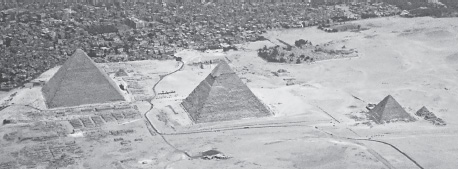
Figure 1.1. The Giza pyramids and the Giza Necropolis in Egypt, seen from above. Photo taken on December 12, 2008. Courtesy of Robster1983.
Aiming to disprove the traditional chronology held by established Egyptology, West has pursued and documented an enormous amount of evidence, and then written and published his findings. He pointed out that the ancient Egyptians spoke highly of the “first time,” or “Zep Tepi,” but modern Egyptology ignores or, for some reason, downplays this significantly. West believes that once the establishment investigates Zep Tepi, a can of worms will be opened, shattering what has been taught for hundreds of years. Evidence of this mysterious time is found on the Palermo stone, one of the earliest Egyptian historical texts, carved on a black basalt stele. Discovered near Memphis in 1866, the Palermo stone’s journey to London took a detour through Sicily, where a Sicilian family kept it in their home and actually used it as a doorstop. Finally, in 1895, a French archaeologist noted its importance.
In 1902 renowned art historian Heinrich Schafer published the first information regarding the Palermo stone, the most important feature of which is the listing of rulers that predate Menes, the first “official” ruler of Egypt.3 This goes back thousands of years into the predynastic period, and into what John Anthony West referred to as the Zep Tepi.
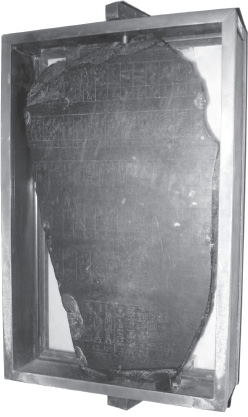
Figure 1.2. The Palermo stone is a list of Egyptian pharaohs and is of great importance to the Egyptian chronology. Regional Archaeological Museum in Palermo (September 28, 2006). Courtesy of Giovanni Dall’Orto.
John Anthony West is not alone in his theory about Zep Tepi. Robert Bauval, a best-selling author who first pointed out the Great Pyramid’s alignment with the stars of Orion’s belt, also shares West’s view.4 Born and raised in Egypt, Bauval has focused his studies on the fascination the ancient Egyptians had with the stars. Bauval provided the first clues as to where to look concerning the roots of possible alien contact deep in Egypt’s past by pointing out the ancient Egyptians’ strange obsession with the star Sirius. The ancient Egyptians were fixated on Sirius, which they called Sa-Ptah in hieroglyphs. According to the ancient indigenous teachings of Egypt, this means “The One who comes from the Blue, through the waters, from the stars.”5 Ptah was the predynastic god of creation in Memphite theology. We know the core components of legends and myths; they do not develop spontaneously. They are based on reality, and one thing we know about reality is that it is not supernatural. It is therefore worth considering that Ptah may have been a real being, perhaps an emissary from an interstellar race. Clues to how far back this traveling starseed goes might require dating techniques a little more sophisticated than what we currently have at our disposal.
We use what is called carbon-14 dating to determine the age of artifacts. It is the traditional method accepted by scholars. However, we should point out that carbon-14 dating is extremely limited and susceptible to all types of errors because it works only on organic materials, and simply touching organic materials contaminates a sample. Stone cannot be carbon-dated but can be dated by the use of precessional astronomy. Precession is the motion of the axis of the Earth, which wobbles like a spinning top due to gravitational pull. Spanning a period of 26,000 years, this remarkable cycle is due to a synchronicity between the speed of the Earth’s rotation around the Sun and the speed of rotation of our galaxy. In order to move one degree on the horizon it takes seventy-two years. This is a process the dictionary refers to as a “Platonic year,” which is described as “a period of about 26,000 years, equal to the time required for a complete revolution of the equinoxes.”6 The word horizon stems from the ancient Egyptian, meaning the line in the sky where both the Sun and Moon disappear. The line was guarded by the god Horus, thus evolving etymologically into the word horizon that all English speakers are familiar with.
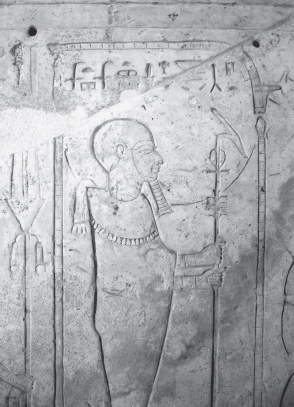
Figure 1.3. The god Ptah at the Louvre Museum. Courtesy of Neithsabes.
Plato’s “year” was understood by ancient cultures across the globe, with more than two hundred mythologies related to this vast cycle of time. At least thirty different cultures from antiquity have since handed down tales and folklore concerning their own interpretation of what we know today as precession.7 It is amazing to think that only three hundred years ago one of the world’s brightest minds had trouble understanding this solar event, when thousands of years in the past it was common knowledge for the ancient Egyptians.
Intrigued by this process, astronomer Sir Isaac Newton tried to include this ancient cycle in his philosophies of the zodiac.8 One of the ways to measure the 26,000-year cycle is through the ages of the zodiac, which the ancient Egyptians clearly understood. The zodiac itself is a symbolic translation of precession. Over time the number seventy-two has been used to denote this secret knowledge, and the number has been incorporated in ancient, mythical stories that, at best, make for fanciful reading since the implications are lost to us. Upon closer examination and cross-referencing, we find that these astronomical myths are star maps—mathematical observations of the sky, mixed with astrotheology.
The Temple of the Zodiac celebrates precession and its movement into the era of Pisces. The time it takes Earth to precess one degree on its axis is 71.6 years, a number that has been rounded up to 72, and which appears in strange locations and chronicles in the past. Many examples of the number 72 representing human knowledge of precession can be found in ancient history. For instance, the Egyptian prince Gaythelos is said to have spoken 72 languages, Jesus had 12 disciples (constellations of the zodiac) and another 72 disciples,9 72 languages were confused by the Tower of Babel, Confucius also had 72 disciples, the number of steps on Jacob’s ladder is 72, there are 72 immortals in the history of Taoism, and the Egyptian god Osiris was enclosed in a coffin by 72 followers of his evil brother Set.10 These recurring nods to the number 72 don’t make any sense unless we understand the symbolism of precession.
In ancient belief systems it was agreed that humans lived in 5,000year stages. Viewing the past as a Golden Age, we can clearly see how we have degenerated into a Dark Age. Despite being told that we are at the height of our development, one quick glance at the world shows things are getting worse by the minute. This is not a Golden Age. Golden Ages are times of enlightenment when civilizations reach high points in architecture, spirituality, and benevolence. This is considered to decline slightly in the Silver Age, further deteriorating in the Bronze Age, and reaching extreme levels of chaos, corruption, and ignorance in the Iron Age or Dark Age. Then, the cycle works its way back up to the next Golden Age. December 21, 2012 marked the end of a 26,000year cycle that put humanity at the bottom of the barrel of the Dark Age. Physically, we are heading deeper into the Dark Ages; meanwhile our consciousness, along with the universe, is expanding in the spiritual realm, seeking another Golden Age.
The ancient Egyptians’ knowledge of the stars was at its height in previous Golden Ages. While it is possible to conceive of an age of enlightenment that would have organically reached heightened levels of technology, required to investigate star systems, it is more probable to imagine that a halfway encounter took place.
As a global society we have exchange programs across all fields. It is a common practice to study outside one’s own field of expertise. Many exchange students opt to remain, for one reason or another, in the host country. Military postings, for example, result in commingling with locals. The technology available during Egypt’s ancient Golden Age could have very well included interstellar travel. Therefore, it is not far-fetched in the least to propose that the knowledge that blossomed in ancient, Golden Age Egypt was the result of a long-term interstellar exchange. Pinpointing the time when this could have taken place is the real trick.
Geologist Robert M. Schoch claimed that the weathering on the Sphinx and the Sphinx enclosure were formed by runoff from rain. This claim was met with absolute silence from the academic world; nobody uttered a peep, essentially accepting the claim as valid. The last time Egypt had rains like that was anywhere from eight thousand to eleven thousand years ago.11 These dates are in conflict with the established view that Pharaoh Khafra built the Sphinx in 2,500 BCE (see plate 1). It is interesting to note that according to Travel Cairo, “It is not known by what name the original creators called their statue, as the Great Sphinx does not appear in any known inscription of the Old Kingdom, and there are no inscriptions anywhere describing its construction or its original purpose. The commonly used name Sphinx was given to it in classical antiquity, about two thousand years after the accepted date of its construction.”12
The controversy appears to indicate that the Sphinx and the surrounding Giza complex are extremely ancient, far older than the establishment dares to admit. A good way to judge how old these monuments can possibly be is to examine the migration of the Nile River. Using a geologic mapping program on a computer, we can see that the riverbed migrated all the way from the west beyond fifty kilometers, then passed across the plateau, and went right up to the pyramids.13
Based on geological time, it would take tens of thousands of years for the Nile to make that migration. We can compare that to places like the ancient city of Tiahuanaco in Bolivia that almost certainly was on the edge of Lake Titicaca and now is fifty miles away.14 Precession changes the whole idea of how ancient these places could have been. It takes thousands of years for a river to make this tilting journey (see plates 2 and plate 3).
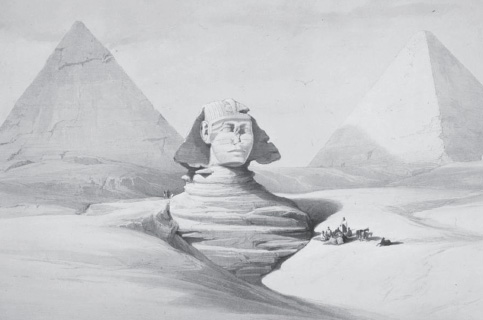
Figure 1.4. The Great Sphinx, pyramids of Giza (July 17, 1839). From David Roberts, Egypt & Nubia, From drawings made on the spot by David Roberts and lithographed by Louis Haghe, vol. 1, part 18, 1846–1849.
Today, the oases of El Kharga and Faiyum run parallel to the Nile, but 100 kilometers west. It seems that the river migrated all the way from there to its current course. In 2010 evidence of a huge ancient harbor was found near the Bent pyramid. The harbor connects to one of the pyramid’s temples by way of a 140-meter-long causeway and lends further credence to theories concerning the Nile’s migration. This discovery was made by a joint venture of the Cairo department of the German Archaeological Institute and the Free University of Berlin. Dr. Nicole Alexanian of the German Archaeological Institute believes the area surrounding the pyramid complex was filled with water and that it provided a perfect harbor for ships to enter the canals that appear to have surrounded the Giza Plateau,15 postulating that in Egypt’s ancient past the waters of the Nile were in sync with the pyramid complex. This discovery points to an advanced age when elements of water, in conjunction with certain types of stone and crystal, all were blended to create the stone used in the pyramid fields. This Golden Age has been lost in the mists of time, but looking at myths with fresh eyes in a fast-paced digital world, we can recognize greater forces at play.
Upon closer study of Egypt’s most mysterious character, Thoth, an interesting picture emerges. Thoth was highly worshipped in the Egyptian pantheon. Late-period (700–323 BCE) writings describe him as a god, holding the heart and tongue of Ra. In the 1908 edition of The Americana: A Universal Reference Library, Thoth is described as
one of the most interesting figures in Egyptian mythology . . . he is the god of time and its divisions; he is the measurer, and god of measurements. He is the conductor of the dead. He is also the god of human intelligence, to whom are attributed all the productions of human art . . . all the literature of Egypt is attributed to him—all the writings that relate to the different sciences, mathematics, astronomy, medicine, music. Thoth is also credited with the invention of alchemy and magic.16
In the earliest Egyptian writings, Thoth wasn’t a god but a flesh-and-blood ruler, known as an important teacher of humankind who supposedly left behind a great library of knowledge and science for future generations’ edification. Phoenician historian Sanchuniathon wrote in the thirteenth century BCE that Thoth was once the ruler of a western island kingdom before the Egyptian priests turned him into a god.17 Sanchuniathon and his writings were thought to have been invented by the Greeks until excavations in Syria in 1929 revealed Phoenician writings supporting his claims, made centuries before by the Greek translations from Philo of Byblos. These writings give us a detailed account of Thoth’s arrival and influence on ancient Egypt.18 The western island Thoth may possibly be ascended from is an Atlantis-type of lost civilization. The Atlantis theory has always been ridiculed by academia but on July 2, 2012 things got exciting when the Daily Mail published an article about a team of research divers from St. Andrews University who discovered underwater mounds and traces of a village in Britain swallowed by the sea more than 8,500 years ago.19
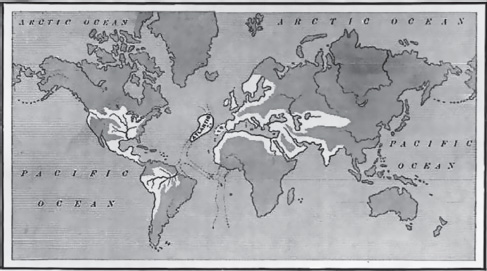
Figure 1.5. Map of the Atlantean Empire, from Atlantis: The Antediluvian World (1882). Courtesy of the estate of Ignatius Donelly.
The Egyptians grasped an advanced level of astronomy and mathematics that we are only now beginning to understand. If Thoth was from Atlantis or some other form of lost civilization, one possible explanation is that Thoth may have descended from an interstellar race that once visited Earth eons ago. Possibly, he inherited a profound amount of knowledge and a mastery over the energies that naturally occur in the atmosphere. If this superior knowledge was shared with the ancients, it was ultimately destroyed and forgotten with the passage of thousands of years, which surely included other catastrophic events. It is conceivable that the ancients living in an advanced Golden Age of a distant past understood the cataclysm that results from the Earth’s cycles, or greater cycles that affect other planets, and even other star systems. It stands to reason that any lofty civilization able to discern that future cycles of time bring about cataclysmic events would be plunged into the depths of collective despair. Why? Because humanity, with a complete disconnection from our spiritual nature, would be powerless to avert that disaster. Yet the ancients would have prepared a trigger—magnificent structures strategically built to withstand global catastrophes, skillfully aligned with the stars, engineered to be superconductors of energy, and encoded with symbols to awaken humanity from the depths of the Dark Ages. However, the building of the pyramids is not attributed to Thoth. This possibly dates the construction of these structures to a time before Thoth.
The Golden Age and the subsequent Silver Age marked the time during which the average person no longer had the capacity to live in a state of heightened awareness. The ancients lived in a society far more enlightened and benevolent than ours, but that almost-divine state that exists only in a Golden Age was beginning to fade. As humankind descended into the Silver Age, more of an emphasis was placed on what we refer to as “sacred sites” and “sacred structures.”
As civilization began to lose touch with its individual, inner source of finely tuned awareness, a movement to stabilize this source through external, energy-driven locations began. Many of these structures in Egypt inspire awe and wonder, and even today exude a palpable and measurable energy force field. The Great Pyramids certainly are not, nor were they ever intended as, tombs. Despite the shouts coming from accepted Egyptologist dogma, there isn’t a single shred of evidence supporting the notion that the pyramids were actually built by the Egyptians. Notorious for illustrating everything from applying makeup to what happens in the afterlife, ancient Egyptians are uncharacteristically and strangely mute on how they constructed the pyramids.